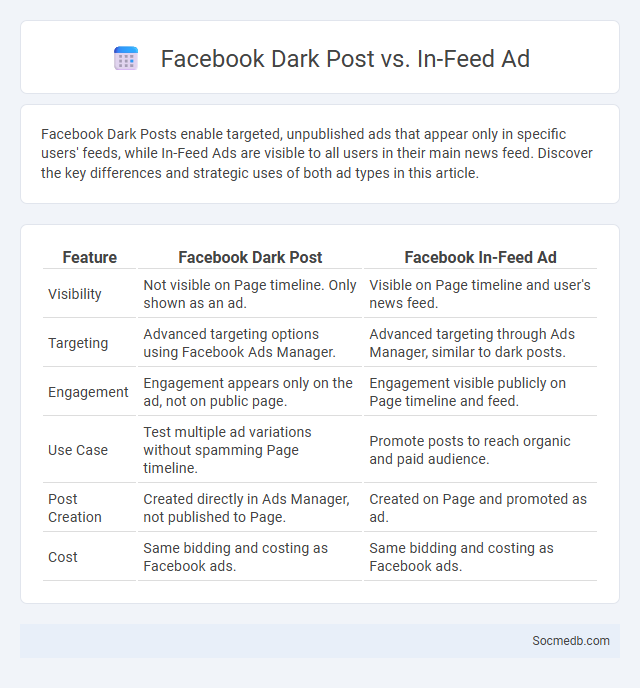
Photo illustration: Facebook Dark Post vs In-Feed Ad
Facebook Dark Posts enable targeted, unpublished ads that appear only in specific users' feeds, while In-Feed Ads are visible to all users in their main news feed. Discover the key differences and strategic uses of both ad types in this article.
Table of Comparison
| Feature | Facebook Dark Post | Facebook In-Feed Ad |
|---|---|---|
| Visibility | Not visible on Page timeline. Only shown as an ad. | Visible on Page timeline and user's news feed. |
| Targeting | Advanced targeting options using Facebook Ads Manager. | Advanced targeting through Ads Manager, similar to dark posts. |
| Engagement | Engagement appears only on the ad, not on public page. | Engagement visible publicly on Page timeline and feed. |
| Use Case | Test multiple ad variations without spamming Page timeline. | Promote posts to reach organic and paid audience. |
| Post Creation | Created directly in Ads Manager, not published to Page. | Created on Page and promoted as ad. |
| Cost | Same bidding and costing as Facebook ads. | Same bidding and costing as Facebook ads. |
Understanding Facebook Dark Posts
Facebook Dark Posts are unpublished ads designed to target specific audience segments without appearing on a brand's main timeline or page feed. These posts enable precise demographic, interest, and behavioral targeting, optimizing ad spend by delivering tailored content to potential customers in their News Feed. Marketers leverage Dark Posts to run multiple ad variations simultaneously, improving campaign performance through A/B testing and enhanced audience engagement metrics.
What Are In-Feed Ads on Facebook?
In-feed ads on Facebook appear seamlessly within a user's news feed, blending naturally with organic posts to maximize engagement. These ads support various formats, such as images, videos, and carousels, enabling advertisers to capture attention through visually appealing content. You can target your audience precisely using Facebook's robust demographic and behavioral data to enhance ad relevance and performance.
Key Differences: Dark Post vs In-Feed Ad
Dark posts on social media are unpublished ads that only appear to targeted audiences, allowing precise control over ad delivery without cluttering your brand's timeline. In-feed ads are visible posts integrated into users' regular social content feeds, offering broader engagement and organic interaction opportunities. Understanding these differences helps you optimize ad strategy for specific campaign goals and audience targeting.
How Facebook Dark Posts Work
Facebook Dark Posts are unpublished page posts used for targeted advertising without appearing on the brand's public timeline. These ads allow precise audience segmentation based on demographics, interests, and behavior, maximizing engagement and conversion rates. Marketers leverage dark posts to test multiple ad variations and optimize campaigns while maintaining control over public content visibility.
Advantages of Using Dark Posts
Dark posts on social media enable precise audience targeting by allowing you to create customized ads without cluttering your public feed, increasing engagement rates. These posts help in A/B testing different content variations to identify what resonates best with your target demographic, optimizing your marketing strategy. By maintaining content relevance and minimizing ad fatigue, dark posts effectively enhance the performance of your social media campaigns.
Pros and Cons of In-Feed Ads
In-feed ads blend seamlessly into social media feeds, increasing user engagement by appearing as native content that matches the platform's style and format. These ads offer precise targeting capabilities based on user demographics, interests, and behavior, driving higher conversion rates for advertisers. However, in-feed ads may disrupt user experience by interrupting organic content flow, leading to ad fatigue and potential negative brand perception if overused or poorly targeted.
Dark Post vs In-Feed Ad: Performance Metrics
Dark posts on social media offer precise targeting and higher engagement rates by appearing only to selected audiences, avoiding clutter in public feeds. In-feed ads deliver broad exposure with visible social proof through likes and comments but often experience lower click-through rates compared to dark posts. Performance metrics show dark posts outperform in-feed ads in conversion rates and cost-efficiency due to tailored messaging and audience segmentation.
Choosing Between Dark Post and In-Feed Ad
Dark posts on social media allow advertisers to target specific audiences without cluttering their main feed, offering precise segmentation and testing opportunities. In-feed ads appear natively within users' content streams, enhancing engagement through natural integration and higher visibility. Selecting between dark posts and in-feed ads depends on campaign goals: dark posts suit targeted messaging and experimentation, while in-feed ads excel in brand awareness and broad reach.
Best Practices for Facebook Ad Campaigns
Maximize your Facebook ad campaign success by targeting specific audience segments based on demographics, interests, and behaviors to increase engagement and conversion rates. Use compelling visuals and concise, clear copy with a strong call-to-action to capture attention quickly. Regularly analyze performance metrics such as click-through rates, cost per conversion, and return on ad spend to optimize your budget and ad placements for the best results.
Frequently Asked Questions: Facebook Dark Posts vs In-Feed Ads
Facebook dark posts are unpublished ads that appear only to targeted audiences and do not show on your business's timeline, while in-feed ads are visible on users' news feeds alongside organic content. Dark posts allow for precise audience segmentation and testing multiple ad variations without cluttering your page, optimizing your ad spend and engagement. Understanding these differences helps you tailor your Facebook advertising strategy for maximum reach and conversion.
 socmedb.com
socmedb.com